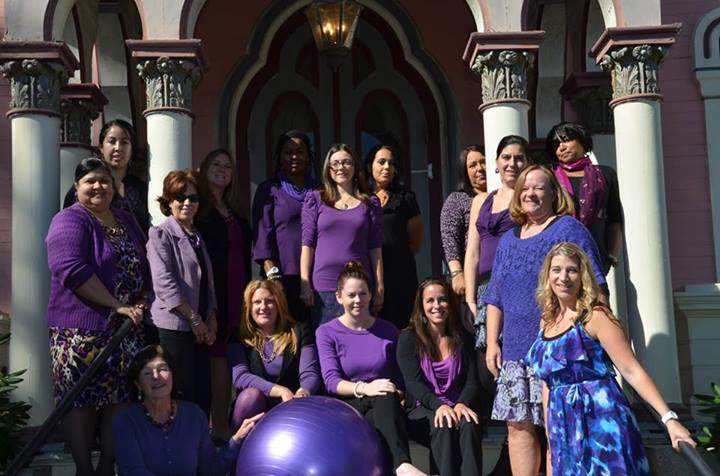
Gala planned for Thursday, October 17th

This year marks the 40th anniversary of The Women’s Center. Hard to even imagine, just 40 years ago, women faced barriers in nearly every facet of life – career, safety, healthcare, and so on. Today, many of these challenges have been mitigated thanks to the determination of those before us persistent on seeking change.
Knowing that grassroots efforts were the source of its success, I wanted to delve into the very founding of the The Women’s Center – How did it form? Why? By whom?! What dynamic women chose to spend their energy fighting for women’s rights?! This month, I was fortunate enough to interview one of those crusaders. Lee Blake, one of the original founders of The Women’s Center, shares her story as a player in the women’s movement and how The Women’s Center came to exist. In fact, the earliest goals were not to improve services for battered women, but rather to fight for women’s rights on a broad scale.
With a vision for change, in 1972 at around the age of 20, Lee teamed up with a small group of friends and began hosting “consciousness-raising groups.” She says, “We were a mix of working career women, college students, and single mothers raising young children alone. We met on a regular basis discussing ‘women’s issues’ until we decided to organize other women and found the Women’s Center.”
Thanks to Blake and that group of friends, The Women’s Center exists today, providing 24/7 access to resources and programs that serve women in need. In fact, The Women’s Center has the distinction of being one of the first centers organized by working-class women on the East Coast.
The early days:
“It probably seems trite now, but all we were aiming for was fair and equitable treatment. We wanted to bring attention to the way women were discriminated against across the country and in the City. We were pushing for changes in standard practice that discriminated against women” adding that at the time, both work opportunities and access to healthcare were extremely limited.
“As single women, we had difficulty finding adequate information on birth control from area doctors. We had to face the attitudes of many that sexually active single women should suffer the consequences of their sexual choices. We were active during the Roe vs. Wade debates around abortion rights and rights to knowledge and control about our own bodies.”
As a result, “Our whole initial work was on birth control. We hoped to begin to tackle one major issue affecting all women and to create a foundation to grow into other issues that women would identify as a priority. We wanted to develop a strong understanding of the issues and challenges facing women that would have to be undertaken to move forward.”

The fantastic crew of the Women’s Center
Despite great determination, Lee and her friends faced a number of challenges. “The ideas of the Women’s Movement weren’t welcomed at the time and the movement was seen as a middle-class movement that didn’t have much in common with working women.” According to Lee, common ground, however, was found surrounding issues of women’s health.
Calling her group “a pretty egalitarian bunch” Lee says their objectives were to collaborate to run a Women’s Health Hotline and to access the attitudes of local gynecologists regarding contraception for single women and gain access to abortion rights. Over time, Lee worked on outreach in the community, started up more consciousness-raising groups, and eventually helped research funding and development opportunities to open the doors of The Women’s Center.
An ‘attitude evolution’:
“Changing the attitudes on the role of women and advocating for our human rights was a legal process as well as an attitude evolution. For many of us, the issue of domestic violence stemmed from a belief that women actually had few rights once they were married or lived with a male partner.”
“Family violence and violence toward women was seen by the larger and law enforcement community as a private affair, a place where people felt they should not intrude even when the lives of women and children were threatened.”
“There really was no framework to discuss it or to help women who were trapped. The Women’s Center helped to change that dynamic in the city and the women’s movement changed the hands-off attitude across the country.”
Making strides:
While today The Women’s Center primarily serves victims of violence and assault, Lee says her earliest goals were to change practices that barred women’s access to birth control as well as enhance work opportunities for women. “We wanted to bring attention to the limited career choices women had. As single mothers worked to raise and care for their families, real options for jobs that paid a living wage were in short supply,” says Lee. “Equal pay for equal work gets a fairer hearing now than it did 40 years ago,” noting that women’s career roles have also greatly evolved.
“I worked on opening the doors for women in nontraditional occupations like construction, police, engineering, etc.,” – jobs which Lee says offered quick training and manageable hours for women to work and still raise a family. “My concern was about the discrimination that women faced in traditionally man’s occupations, but also I was working to create a pathway to economic stability for single women with children.”

If you need help, counseling, or shelter, call the Women’s Center
With hard work, innovation, perseverance, and dedication to the women’s movement, Lee notes the many successes that resulted, including better jobs, equal access to education, and nontraditional employment opportunities. “Women’s issues are certainly paid more attention to now and there is an understanding that women’s issues are often family issues and impact our entire society.”
Broad change:
Lee notes that the women’s movement also created success on a national level. “There is an acknowledgement now in the U.S. that limiting the role of women limits our democracy. The understanding of the importance in development of our human capital across gender, culture, and race is a success of the civil rights and women’s movement.”
When asked about safety and security for women who have been assaulted and abused, Lee adds, “Although we still have a way to go to, we really have achieved a safer world for women here in the U.S. The issues of rape and sexual violence are much better addressed than in the past. Laws and practices of police departments and other social service institutions have evolved. When the Center was forming initially, women felt little to no support in reporting sexual violence.”
Engage for change:
Despite great success, there is still more to be done. Lee says, “We have to remain vigilant and keep up the good fight. I firmly believe that people need to get involved at a greater level. Communities do not move forward without a vision and others pushing and poking the system to move forward. It’s the ability of those who provide the “vision” or the “alternate vision” to collaborate with others and organize people to implement that vision.”
As we may look to women like Lee for inspiration, Lee also refers to the success of others who had ‘visions’ of change. “I go back to quotes from others who have managed to push our society forward toward greater democracy for all. Towards the end of a long life as a progressive, Frederick Douglass was asked how to keep forward movement on a progressive agenda. I hold his words dear to my heart and have followed them most of my years as a community organizer as he was heard to whisper “Agitate, agitate, agitate.”
 New Bedford Guide Your Guide to New Bedford and South Coast, MA
New Bedford Guide Your Guide to New Bedford and South Coast, MA








